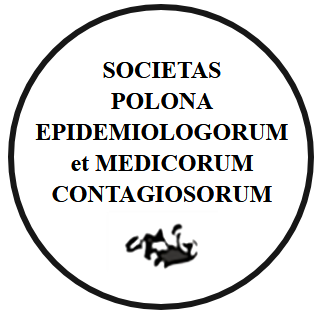ABSTRACT
INTRODUCTION. The epidemiological situation of infectious diseases in Poland in 2020, including pertussis cases, was significantly influenced by the limitation of interpersonal contacts introduced to reduce the transmission of SARS-CoV-2 virus. There was a reduction by more than half in the number of recorded pertussis cases, from 1,629 in 2019 to 753 in 2020. Pertussis is most dangerous for young children, however, it can get sick at any age, and the disease does not leave permanent immunity. Severe pertussis can also develop in the elderly, which may increase the risk of mortality. Adults usually have pertussis is mildly symptomatic and constitute an important reservoir of B. pertussis. The most effective strategy for the prevention of pertussis is still immunization of children in accordance with the Protective Vaccination Program, and in the case of adults, vaccination with the pertussis component in acellular form, repeated regularly every 10 years.
OBJECTIVES. The aim of the study was to assess the epidemiological situation of pertussis in Poland in 2020 compared to the situation in previous years, with particular emphasis on the assessment of the vaccination status of children against pertussis.
MATERIAL AND METHODS. The assessment of the epidemiological situation of pertussis in Poland was performed on the basis of the results of the analysis of unit reports of pertussis registered in the NIPH NIH – NRI in the EpiBaza system and data from the annual bulletin “Infectious diseases and poisonings in Poland in 2020” and the bulletin “Vaccinations in Poland in 2020”.
RESULTS. In 2020, 753 cases of pertussis were registered. The incidence was 1.96 per 100,000 population and was lower compared to the incidence in 2019 (4.24). The highest incidence of pertussis occurred in the age group 0-4 years (9.9), and high in children and adolescents aged 5-9 years (5.1) and 10-14 years (6.0 per 100,000 population). About half of the cases concerned people over 15 years of age. In general, a higher incidence of women was observed than that of men, as well as a greater number of cases in cities than in rural areas. In 2020, among people suffering from pertussis, 206 people (i.e. 27%) required hospitalization. In 2020, one fatal case of the disease was reported to the epidemiological surveillance system.
SUMMARY AND CONCLUSIONS. In Poland, in 2020, there was a decrease in the number of pertussis cases by more than a half compared to the previous year. Despite the decline in disease rates, pertussis remains a public health problem as immunization-induced immunity is not sustained throughout life. Increasing the number of people susceptible to pertussis may lead to compensatory epidemics in the future, therefore the highest possible level of vaccination of the population, >92-94%, should be maintained to prevent new cases of pertussis.
STRESZCZENIE
WSTĘP. Na sytuację epidemiologiczną chorób zakaźnych w Polsce w 2020 r., w tym zachorowań na krztusiec, znacząco wpłynęło ograniczenie kontaktów międzyludzkich wprowadzonych w celu redukcji transmisji wirusa SARS-CoV-2. Odnotowano zmniejszenie o ponad połowę liczby zachorowań na krztusiec, z 1 629 w 2019 r. na 753 w 2020 r. Krztusiec jest najgroźniejszy dla małych dzieci, jednak można zachorować w każdym wieku, a przechorowanie nie pozostawia trwałej odporności. Ciężki przebieg krztuśca może rozwinąć się także u osób starszych, co może zwiększać ryzyko śmiertelności. Osoby dorosłe zwykle chorują na krztusiec skąpoobjawowo i stanowią istotny rezerwuar B. pertussis. Najskuteczniejszą strategią zapobiegania zachorowaniom na krztusiec nadal pozostaje immunizacja dzieci zgodnie z Programem Szczepień Ochronnych, a w przypadku osób dorosłych, szczepienie z komponentem krztuścowym w postaci bezkomórkowej powtarzane systematycznie co 10 lat.
CEL PRACY. Celem pracy była ocena sytuacji epidemiologicznej krztuśca w Polsce w 2020 r. w porównaniu z sytuacją w ubiegłych latach, ze szczególnym uwzględnieniem oceny stanu zaszczepienia dzieci przeciw krztuścowi.
MATERIAŁ I METODY. Ocena sytuacji epidemiologicznej krztuśca w Polsce została wykonana na podstawie wyników analizy jednostkowych zgłoszeń zachorowań na krztusiec zarejestrowanych w NIZP PZH – PIB w systemie EpiBaza oraz danych z biuletynu rocznego „Choroby zakaźne i zatrucia w Polsce w 2020 r.” oraz biuletynu „Szczepienia ochronne w Polsce w 2020 r.”.
WYNIKI. W 2020 r. zarejestrowano 753 zachorowań na krztusiec. Zapadalność wynosiła 1,96 na 100 tys. mieszkańców i była niższa w porównaniu z zapadalnością w roku 2019 (4,24). Najwyższa zapadalność na krztusiec wystąpiła u osób w grupie wieku 0-4 lata (9,9), a wysoka u dzieci i młodzieży w wieku 5-9 lat (5,1) i 10-14 lat (6,0 na 100 tys. mieszkańców). Około połowa zachorowań dotyczyła osób powyżej 15 r.ż. Obserwowano ogółem wyższą zapadalność kobiet w porównaniu z zapadalnością mężczyzn, a także większą liczbę zachorowań w miastach niż na wsi. W 2020 r. wśród osób chorych na krztusiec, 206 osób (tj. 27%) wymagało hospitalizacji. W 2020 r. zgłoszono w systemie nadzoru epidemiologicznego jeden przypadek choroby, która zakończyła się zgonem.
PODSUMOWANIE I WNIOSKI. W Polsce w 2020 r. odnotowano spadek liczby zachorowań na krztusiec o ponad połowę, w porównaniu do roku ubiegłego. Pomimo spadku liczby zachorowań, krztusiec nadal pozostaje problemem zdrowia publicznego, ponieważ odporność uzyskana dzięki szczepieniom nie utrzymuje się przez całe życie. Zwiększenie liczby osób podatnych na zachorowanie na krztusiec, może prowadzić do wystąpienia epidemii wyrównawczych w przyszłości, dlatego należy utrzymać jak najwyższy poziom zaszczepienia populacji, >92-94%, aby zapobiec nowym przypadkom zachorowań na krztusiec.
You can change cookies settings in your browser. Restricted use of cookies in the browser configuration may affect some functionalities of the website.





